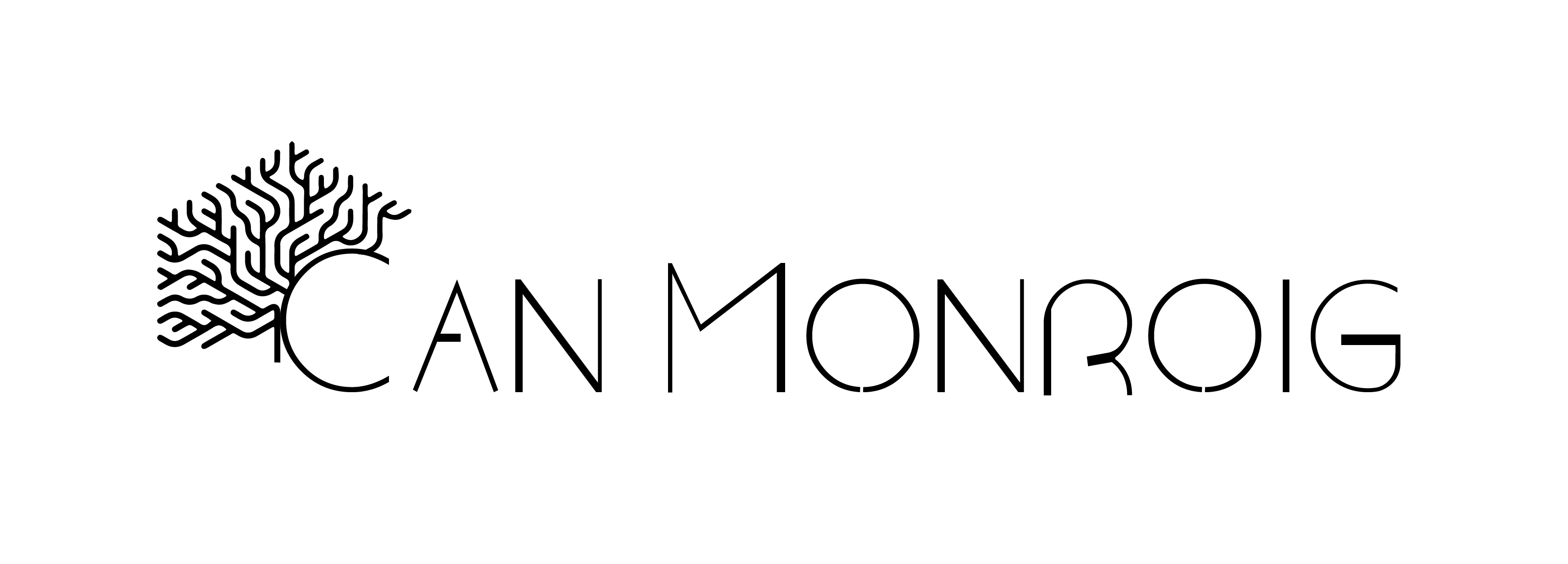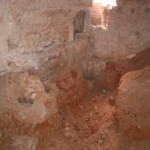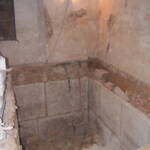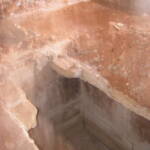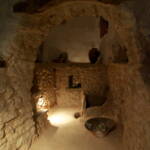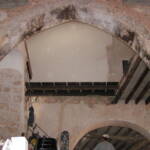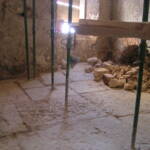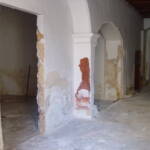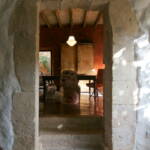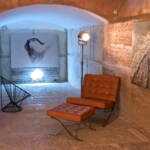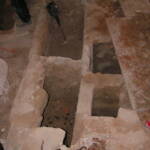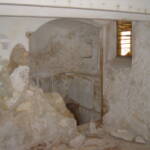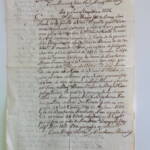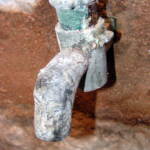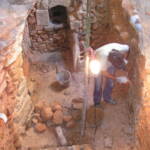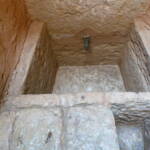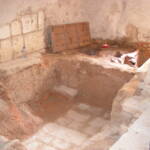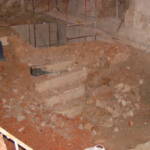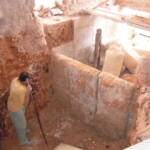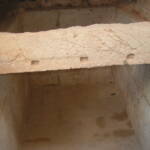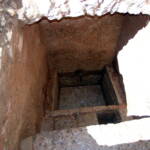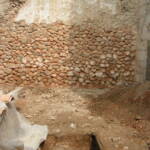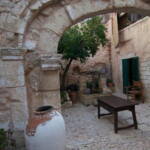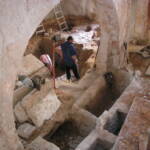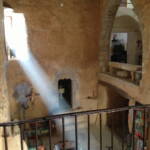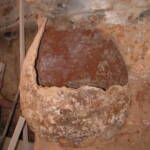
Can Monroig and the Jewish quarter of Inca
The Can Monroig mansion, located at number 22 on Can Valella street, is situated in the Jewish quarter of Inca, the Jewish quarter that was made up of the blocks of houses between the streets of Sant Francesc, la Virtud, Can Valella, Pare Cerdà, el Call and la Rosa. The current two-storey house, dating from the 16th century, has a façade with smooth walls decorated with small stones, similar to the façade of Can Siquier. The openings are formed by various windows and a semicircular arch entrance door with stone voussoirs, as is the lower part of the façade. In the same way as in the aforementioned Can Siquier, inside there are some remains from the Baroque period (carpanel arches).

This house was closed for many years and over time it deteriorated, but a few years ago it was bought and its new owners carried out a major restoration that brought to light many architectural elements that evidenced the medieval past of the house.
The Gothic elements of the building that can be seen today are made up of a series of pointed and semicircular arches, as well as a doorway and a lintelled window. The interior of the house is therefore made up of two bays. In the first bay there are three rooms perpendicular to the façade and separated by arches. At the entrance to the house on the left wall there is a baroque basket-shaped arch, followed by a large medieval stone pointed arch. On the right side there is a whitewashed semicircular arch that leads to a room in which there is also a blind pointed arch. The first bay is separated from the second by a wall in which there is a lintelled entrance between the two bays and, on its right side, a window ending in a semicircular arch that is most likely from the medieval period due to its great similarity to other entrances and windows found in Gothic buildings of the period (Palace of the Almudaina, Palace of the Kings of Mallorca in Sineu, Torre dels Enagistes in Manacor, etc.). We do not rule out that it could have been a portal at one time.
In the second bay and on the left wall there is a stone doorway with a lintel and a wooden beam, then a square window and finally a stone doorway, now with a lintel but originally finished with a semicircular arch, the same as the one in the wall separating the two bays. Given its shape and location, we think that these are also medieval remains. At the back of the house is the courtyard, where we find a Baroque basket-shaped arch, the inner part of which stands out, as we see that there was another one before it, also basket-shaped, and another even older one, which due to the placement of the stones must have been pointed. In addition, on the right side you can still see the start of what must have been the rib of the cross vault. On the other side of the arch, on the back wall, the shape of the pointed arch is clearly visible and, due to the width of the space, we can think that it was a space covered by two sections with a ribbed vault.
Once these architectural remains have been discovered and the Jewish quarter, where the house is located, has been dated to the 14th century, it is easy to think that we are talking about Gothic remains that most likely date from this same century or from the 13th.
In addition to these discoveries, the entire floor was raised during the restoration of the house and a whole series of very interesting elements were also found. It is worth noting that, on the right side of the entrance, an ancient oven was found that was buried below street level, as well as a whole series of stone vats and tanks spread throughout the house and connected to each other by pipes made of clay. In addition, it is known that the house also had a wine cellar and a cistern is still preserved. In the courtyard there are also two tanks, one larger than the other. In the smaller one, steps were found that lead to the inside of the tank where there is a bronze tap with anthropomorphic decoration (two eyes and a nose). Unlike the architectural remains formed by the various arches, in the case of the discovery of the oven, the various deposits, cisterns and wells, we do not dare to date them, since until now they have not been studied archaeologically and, therefore, we do not have convincing dates that allow us to know either what their use was or when they were built. In addition, it must also be taken into account that Can Monroig is a house in which many transformations and extensions have been carried out over the centuries, which makes its study even more difficult. However, despite everything, it is necessary to take into account some sufficiently important dates that in the future and after an appropriate archaeological study, could help to decipher these discovered elements. Thus, once again, we must highlight the fact that the house is located in what was the Jewish quarter of Inca during the 14th century. For this reason, we believe it is necessary to point out some bibliographical data on the Jews in Mallorca, in Inca, and on the establishment of our Jewish quarter, without forgetting the Jewish quarter of Palma.
The Jewish quarter of Inca
It is important to note the presence of Jews in Mallorca in the 5th century, both in Mallorca and in Menorca, as documented in a letter from Bishop Severus in 417. Also, thanks to various sources, we know that during the Islamic domination of the island (902-1229) there was a significant community of Jews. Thus, when James I conquered Mallorca in 1229 he already found a significant Jewish community in the city of Palma, but also in other places in the Part Forana such as Inca, Petra, Montuïri, Felanitx, Sineu, Alcudia, Sóller and Pollença. The Jewish community of Inca is already documented in 1232, when James I granted compensation to the Jews of Inca, the Almudaina de Gomara (Palma), Petra and Montuïri. A document from 1240 confirms the presence of Jews in Mallorca, granting them royal protection, a privilege that was confirmed by the king himself in 1247.
We have more documentation regarding the Jewish community of Inca during the years that make up the 14th century. These dates are documented in the “morabatí” books of the years 1329 and 1336. We also know that during these years the Jews of Inca still did not have a neighbourhood (Jewish quarter) to live in together, but rather lived spread out in different places in the town. However, they did have a good organisation under the Jewish institution called aljama, which was approved by the king and consisted of counsellors, secretaries and procurators, as well as enjoying a certain public independence. In the year 1346, as a consequence of the important and constant clashes between some of the members of the Jewish community and the Christian community, King Pedro the Ceremonious ordered the construction of a Jewish quarter for the town of Inca. Despite the royal decision and because of the great decline in the Jewish population after the plague of 1348, it was not until 1372 when the Jewish quarter of Inca was finally established, although in 1353 the jurors of Inca had already asked the governor to establish a Jewish quarter and he assigned it to a place located in the Sant Bartomeu neighborhood, specifically in Martí Metge street, but the Jews did not like the place because of the poor condition of the houses, many of which were in ruins, and they appealed to the Lord King to grant them another place to settle. Finally King Pedro IV of Aragon, as we have seen above, in 1375 granted them a new place located in the so-called d'en Pascolet street, located in the Sant Francesc neighborhood.
The assault on the Jewish quarter in 1391
The Jewish quarter of Inca, following a similar case to that of Palma, was surrounded by a wall and closed by two doors, one of them most likely on Sant Francesc Street, as it is stated in the documents of 1372, where the Jews asked that one of the doors “be made in Sant Francesc Street”. Despite everything, the fact that the Jews had their own neighbourhood closed off from the rest of the town was not enough to stop the clashes and attacks on Jewish houses by the Christians, and in 1391 the Jewish quarters of Palma and Inca were attacked. The Christians carried out various altercations in which they perpetrated numerous acts of pillage and destruction, murdered a large number of Jews (in reference to Inca, the documents speak of an almost total extermination) and burned houses and shops in the Jewish quarter, leaving the entire neighbourhood razed.
Returning to Can Monroig
As a final conclusion, and having located the house of Can Monroig within what was once the Jewish quarter of Inca, a final observation takes us to the pointed arch located at the entrance of the house. On the arch we can still see remains of soot that covered the arch when it was found. In the second bay of the house, next to the doorway that gives access, on the left there is another doorway with a lintel and a burnt wooden beam. These remains must necessarily be the result of a major fire that occurred in the house and the fact that they are found in architectural remains from the Gothic period makes us think that they could be directly related to the attack on the Jewish quarter in 1391, since it is documented in the Història de Mallorca by Pere Xamena that houses and shops were burned during the disturbances. It is also worth highlighting the first volume of the History of Mallorca published by Editorial Moll, which states that the “lower classes” of the city are united with the pages assaltant the Call, creating the cases and assassinating some 300 games (…) The mateix attempted to have supported the Call d'Inca.
Guillem Alexandre Reus i Planells Art historian
More information:
Jewish quarter of Inca (tumblr blog)
Jewish quarter of Inca (google plus)
Can Monroig and the Jewish quarter of Inca (pinterest)
